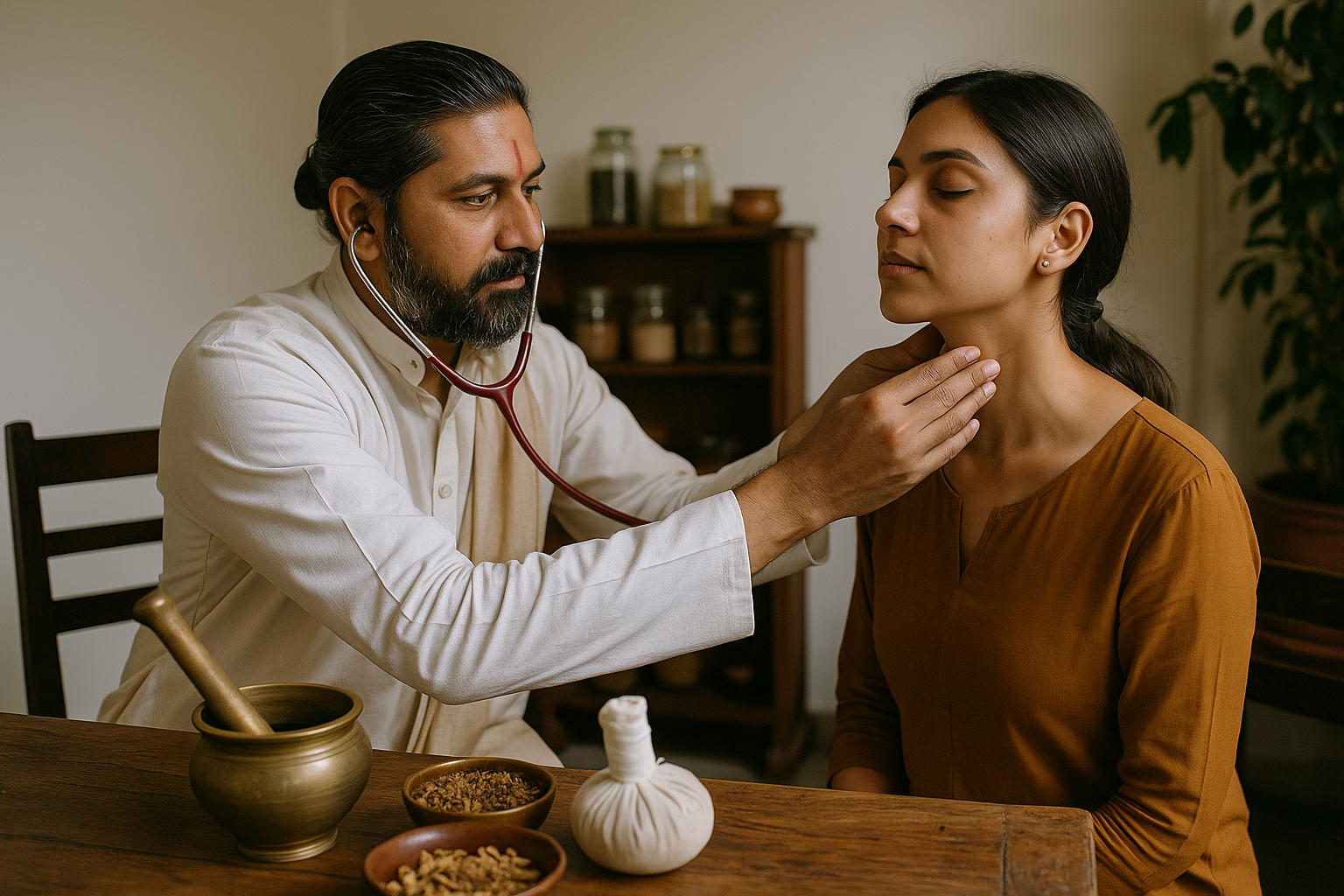Ask Ayurvedic doctor a question and get a consultation online on the problem of your concern in a free or paid mode. More than 2,000 experienced doctors work and wait for your questions on our site and help users to solve their health problems every day.
Shop Now in Our Store
Hyperthyroidism Ayurveda: What You’ve Probably Overlooked About Your Overactive Thyroid

Introduction
If you’ve ever felt like your body’s running faster than your mind — racing heart, unexplained weight loss, that weird wired-tired sensation — you might already know what hyperthyroidism feels like. And trust me, if you’re here, googling “hyperthyroidism Ayurveda,” you’re probably looking for something deeper than just a textbook answer. Something holistic, sustainable… maybe even ancient.
Hyperthyroidism — simply put — is when your thyroid gland (a tiny butterfly-shaped thing in your neck) starts producing way more hormones than your body actually needs. It’s like your internal thermostat is stuck on “overheat.” But while conventional medicine offers antithyroid meds, beta-blockers, or even radioactive iodine, many people (especially those burned out by side effects or recurring symptoms) are turning toward Ayurveda for a gentler, yet thorough, solution.
And it’s not a fringe idea anymore. The World Health Organization acknowledges the rise in thyroid disorders globally, especially among women. Studies estimate that thyroid conditions affect 200 million people worldwide — and the numbers keep climbing. Meanwhile, Ayurvedic medicine — with its 5,000-year-old roots — is being studied more seriously for chronic conditions, including hormonal imbalances like this one. It's not just turmeric and ghee anymore — this stuff is getting attention in clinical research circles.
This article is your deep-dive into hyperthyroidism from an Ayurvedic lens. We’ll explore what causes it (hint: it’s more than just stress), how Ayurveda sees the disease, how to spot it early, what herbs and foods can actually help, and what real people have experienced after ditching the one-size-fits-all medical script. Oh — and we’ll also go there with the less-talked-about stuff: misdiagnosis, lifestyle contradictions, and when Ayurveda isn’t enough.
So, what’s in it for you? If you’re tired of vague wellness advice and want practical, well-rounded solutions that feel human, this is your jam. Whether you’re newly diagnosed or just curious about natural thyroid management, this piece is written with a mix of science, soul, and some real talk. Let’s get into it.

Understanding Hyperthyroidism – Ayurvedic Overview
What exactly is hyperthyroidism?
From a biomedical angle, hyperthyroidism is a condition in which the thyroid gland overproduces thyroid hormones — mainly thyroxine (T4) and triiodothyronine (T3). These hormones regulate your metabolism, heart rate, and temperature. Too much of them? Your body feels like it’s constantly on espresso.
Graves' disease (an autoimmune condition) is the most common culprit. Other causes include thyroid nodules, thyroiditis, and — oddly enough — too much iodine. Left unchecked, this can lead to complications: heart arrhythmias, brittle bones, eye problems (Graves' ophthalmopathy), and even thyroid storm, a rare but potentially life-threatening situation.
The pathogenesis? It's not linear. There's an interplay of immune dysfunction, genetic predisposition, stress, infections, and environmental toxins. Basically, your immune system flips out and your thyroid gets caught in the crossfire.
Now, from an Ayurvedic perspective? It's a different story.
Ayurvedic perspective: Imbalance of Doshas in hyperthyroidism
Ayurveda doesn’t recognize hyperthyroidism as a single disease entity. But when you look at the symptoms — restlessness, heat intolerance, weight loss, anxiety, hair thinning — it screams Pitta-vata imbalance.
Here’s how it plays out:
-
Pitta Dosha, the fire element, governs metabolism and digestion. In hyperthyroidism, Pitta is in overdrive — leading to that burning sensation, irritability, and insomnia.
-
Vata Dosha, linked to movement and air, gets disturbed by excessive stimulation and erratic routines — resulting in tremors, palpitations, and dry skin.
Meanwhile, Kapha is often depleted, which is interesting — because Kapha’s grounding qualities could, in theory, buffer some of this chaos. But when diet, lifestyle, and mental stress are all skewed, you get a condition that no single dosha can manage.
Root causes from an Ayurvedic lens?
-
Diet: Excess spicy, salty, or fermented foods.
-
Lifestyle: Overworking, irregular sleep, digital burnout.
-
Emotions: Chronic worry, perfectionism, repressed anger.
Add a genetic or karmic component, and boom — the thyroid becomes the battlefield.
How Ayurveda’s view differs from conventional medicine
Western medicine zooms in on symptoms and lab values. You’re hyperthyroid if your TSH is low and T3/T4 are high. Then come the meds: carbimazole, methimazole, beta-blockers. Sometimes they work. Sometimes you’re stuck on a lifelong pill carousel.
Ayurveda, on the other hand, takes the scenic route.
It’s not just about what the thyroid is doing — but why. What’s your prakriti (constitution)? What’s out of balance? What's your relationship with food, stress, and time?
In other words, it’s personal. A 25-year-old insomniac techie with hyperthyroidism won’t get the same treatment as a 52-year-old homemaker with the same lab results.
And perhaps most radically, Ayurveda doesn't treat the thyroid. It treats you.
Causes and Triggers of Hyperthyroidism (Ayurvedic Insights)
Main underlying Ayurvedic causes of hyperthyroidism
If you ask an old-school Vaidya why someone’s thyroid is freaking out, they won’t pull up a lab report. They’ll probably ask about your daily routine, how often you skip meals, or whether you hold in your emotions too much. Sounds weird? Maybe. But it works — because in Ayurveda, hyperthyroidism is about derailed energy and digestion, not just hormone levels.
At its root, this condition is about aggravated Pitta and Vata doshas.
-
Pitta gets pushed out of balance by constant pressure, spicy food, overexposure to heat, unresolved anger.
-
Vata gets thrown off by lack of sleep, overstimulation, and anxiety.
These two, when stirred into chaos, disturb the body’s Agni (digestive fire), destabilize Dhatus (tissues), and mess with Ojas (vital essence). The result? The thyroid starts misfiring.
You could also say this is a condition of Ati-yoga — excess stimulation. Too much thinking, too much screen time, too much information, too little grounding. The thyroid becomes a casualty of modern life.
Common triggers and risk factors identified in Ayurveda
-
Irregular meals: Skipping breakfast or eating at midnight? That’s a Vata-Pitta trigger.
-
Overwork: Especially without mental breaks — the classic burnout path.
-
Emotional suppression: Not expressing grief, anger, or anxiety builds internal heat and tension.
-
Excessive travel or change: Aggravates Vata, destabilizes everything else.
-
Genetic predisposition: Yes, Ayurveda acknowledges this too — but through karmaja vyadhi (hereditary diseases).
Why modern lifestyle contributes to rising cases of hyperthyroidism
Let’s be real — our daily lives are practically a checklist of how to develop thyroid imbalance.
-
We wake up to alarms, rush meals, sit all day, stare at screens till midnight.
-
Stress is glorified. Hustle is a badge of honor.
-
We eat food cooked three days ago, or straight out of delivery boxes.
-
We never slow down — even when we’re falling apart.
Ayurveda sees this overstimulation and irregularity as poison for the thyroid. No surprise that thyroid disorders — especially in women — are hitting all-time highs. We're living in constant Pitta-Vata aggravation, and the thyroid is just the messenger.
Recognizing Symptoms & Early Signs of Hyperthyroidism
Typical symptoms of hyperthyroidism
You’d think something as specific as a thyroid imbalance would have very clear signs. But nope — it often starts subtly.
-
Unexplained weight loss (even when you’re eating more than usual)
-
Rapid heartbeat or palpitations — especially at rest
-
Tremors — usually in the hands
-
Increased sweating
-
Heat intolerance — you feel too hot even when others are fine
-
Anxiety, irritability, or mood swings
-
Frequent bowel movements or even diarrhea
-
Fatigue — yes, despite being “wired,” you feel worn out
-
Sleep disturbances — trouble falling or staying asleep
-
Menstrual irregularities — often lighter or shorter periods
-
Thinning hair or brittle nails
Ayurveda ties these to Vata and Pitta dysfunction. Think of it like a wind (Vata) blowing on a wildfire (Pitta) — the result is unstable, fast, and destructive.
Less obvious or overlooked signs
-
Sudden food cravings — especially for salty or spicy foods
-
Neck discomfort or visible swelling in the throat
-
Dry eyes or weird eye pressure
-
Loss of libido
-
Shaky voice or vocal strain
-
Feeling out of sync — a vague sense that your body’s moving faster than your mind
Often, these are brushed off as stress or lifestyle side effects. But in Ayurveda, these whispers are early warning bells — the doshas are already disturbed.
When should you seek Ayurvedic help? And when can’t it help?
Honestly? The earlier, the better.
If you're feeling “off” — even if your TSH levels are borderline — that’s the sweet spot for Ayurvedic intervention. Ayurveda shines at restoring balance before full-blown disease kicks in.
However, if you’re already in a severe state — say, a thyroid storm, extreme weight loss, or dangerous heart palpitations — then conventional medicine is absolutely essential in the short term. Ayurveda can help support recovery, but it's not a substitute for emergency care.
Also: if you’re pregnant, postpartum, or dealing with multiple conditions, your Ayurvedic treatment must be supervised carefully. Self-medicating is not the move here.

Ayurvedic Diagnosis Methods for Hyperthyroidism
Pulse diagnosis, tongue analysis, and other traditional methods
Okay, here’s where things get poetic.
Ever had someone check your pulse for two minutes — eyes closed, no machines — and then tell you you’re stressed, not sleeping well, and probably craving sweets at night? That’s Nadi Pariksha, or Ayurvedic pulse reading. It’s kind of magical, and also legit.
For hyperthyroidism, a trained Vaidya might feel:
-
A rapid, “jumping” pulse (indicative of Vata-Pitta aggravation)
-
Irregular rhythm — kind of like fluttering or skipping
Then there’s Jihva Pariksha — tongue diagnosis. A dry, reddish tongue with fine tremors might reflect heat (Pitta) and nervous disturbance (Vata). Sometimes there’s a thin white coating — a sign of Ama (toxins).
Other tools?
-
Eye observation — hyper-alert, red, or bulging eyes
-
Skin analysis — dryness, hotness, or increased sensitivity
-
Urine and stool analysis — used to gauge digestive health and toxin accumulation
Determining Dosha imbalance specific to hyperthyroidism
There’s no one-size-fits-all here.
Some patients will show dominant Pitta aggravation: red skin, anger, sharp hunger, excess heat. Others might be Vata dominant: insomnia, palpitations, dry hair, anxiety. Occasionally, there's a mixed picture — the worst kind to manage.
A good Ayurvedic doctor will also factor in your Prakriti (natural constitution) and Vikriti (current imbalance). So a naturally Kapha person who develops Vata-Pitta hyperthyroidism? That’s a complex case — and needs personalized treatment.
It’s not about suppressing symptoms. It’s about understanding your body's language.
Ayurvedic Treatments & Remedies for Hyperthyroidism
Ayurvedic herbs and medicines effective for hyperthyroidism
Let’s get nerdy (in a helpful way). Here are some go-to herbs and classical formulations:
-
Ashwagandha (Withania somnifera) – Adaptogen, balances Vata, calms the nervous system
-
Brahmi (Bacopa monnieri) – Nervine tonic, reduces mental hyperactivity
-
Shankhpushpi – Excellent for stress-induced thyroid imbalance
-
Kaishore Guggulu – Anti-inflammatory, clears Pitta toxins
-
Saraswatarishta – Rejuvenative tonic for nervous and hormonal system
-
Praval Pishti – Coral calcium, cooling, helps with heart palpitations and heat
-
Punarnavadi Mandur – Works on water metabolism, useful if there’s swelling or fluid retention
⚠️ Dosage depends heavily on your constitution, severity, and any co-existing conditions. These are not over-the-counter band-aids. Always consult a practitioner before starting herbs — especially during pregnancy, breastfeeding, or if you’re on thyroid meds.
Ayurvedic therapies and Panchakarma treatments
For deeper detox and reset, Panchakarma therapies may be recommended:
-
Shirodhara: Oil poured on the forehead — calms Vata, improves sleep and focus
-
Abhyanga (oil massage): Grounds Vata, reduces anxiety
-
Nasya (nasal therapy): Clears channels, particularly helpful for hormonal imbalances
-
Virechana (therapeutic purgation): Removes excess Pitta and toxins from the gut
-
Basti (medicated enema): Especially good for chronic Vata aggravation
These therapies must be timed and supervised correctly. Done wrong? They can worsen the imbalance.
Effective Ayurvedic home remedies and self-care advice
-
Start your day with warm water + ghee — gentle, nourishing, grounding.
-
Avoid raw or cold foods — they increase Vata.
-
Oil massage at home (even once a week) calms the system.
-
Sip cumin-coriander-fennel tea after meals to balance Pitta.
-
Practice Bhramari Pranayama or alternate nostril breathing daily.
-
Digital detox for 30 minutes before sleep — seriously, this matters more than you think.
These might sound too simple — but when practiced consistently, they shift your baseline state. And for hyperthyroidism, baseline calm is the goal.
Diet & Lifestyle Recommendations for Managing Hyperthyroidism
Recommended foods and dietary guidelines for hyperthyroidism
Let’s get into what you should eat — because honestly, this matters more than people realize. Ayurveda sees food as medicine, not just fuel. And when your thyroid’s on overdrive, what you put on your plate can either cool the fire... or throw gasoline on it.
Foods that calm Pitta and Vata:
-
Cooked vegetables — especially squashes, zucchini, bottle gourd, carrots, sweet potatoes
-
Whole grains — rice (especially red or brown), oats, barley — all cooked, warm, and slightly oily
-
Dairy — if tolerated, opt for fresh cow’s milk (boiled), ghee, homemade yogurt in moderation
-
Cooling fruits — pears, ripe bananas, melons, pomegranates
-
Spices — fennel, coriander, turmeric, cardamom (small amounts of cumin too)
-
Natural sweeteners — jaggery or raw honey (not heated) in small amounts
🕑 Meal timing: Stick to a routine. Eat three warm, cooked meals a day, with your biggest meal at lunch. No skipping. No raw salads at 9 PM. Your digestion is sensitive when your thyroid is hyperactive.
🥣 Cooking methods: Steaming, boiling, sautéing in ghee or sesame oil. Avoid frying or grilling.
🧂 Salt: Prefer rock salt (Sendha Namak). Regular iodized salt can worsen thyroid symptoms when in excess.
💡 Don’t drink cold water with meals. Instead, sip warm water or herbal tea.
Foods and drinks to avoid for hyperthyroidism
Now for the hard truth — here’s what to avoid if you’re trying to cool down an overactive thyroid and balance your doshas.
-
Caffeine – Yes, even green tea. It spikes anxiety and heart rate.
-
Fermented foods – Pickles, vinegar, kombucha — too much Pitta.
-
Nightshades – Tomatoes, potatoes, peppers — can aggravate inflammation in some cases.
-
Excess salt – Especially iodized table salt. Too much iodine can worsen hyperthyroid states.
-
Processed sugar – Increases metabolic fire, worsens mood swings.
-
Alcohol – Heats the liver, disturbs digestion, spikes Vata.
-
Red meat – Heavy, heating, difficult to digest. Not ideal when your system is already overworked.
-
Cold or raw foods – Ice cream, smoothies, raw salads — all disturb Vata.
⚠️ Dangerous food combos: Milk with sour fruits, yogurt at night, or ghee with honey in equal proportions. Ayurveda is super picky about this — because these combos form Ama (toxins), and that clogs your subtle channels (Srotas).
Daily routine and lifestyle tips to control hyperthyroidism
This isn’t just “eat this, avoid that.” Your Dinacharya (daily rhythm) matters — a lot.
🕔 Morning: Wake up before sunrise (around 5:30–6:00 AM). Scrape your tongue. Drink warm water with a bit of ghee or a pinch of turmeric. Gentle yoga or a 15-minute walk is enough — don’t push your body too hard.
🧘♀️ Mid-morning: Practice alternate nostril breathing (Nadi Shodhana) or Bhramari Pranayama. Great for calming your nervous system.
🕛 Lunch: Make this your biggest, most grounding meal. Warm, cooked, and eaten in peace — not scrolling Instagram.
🛁 Evening: Avoid screens after 8 PM. Massage your feet with sesame oil. Read or meditate. Be boring — your thyroid will thank you.
🛌 Sleep: In bed by 10:00 PM. No exceptions. Hyperthyroidism often worsens with sleep deprivation.
And remember — the goal isn’t to become rigid. It’s to become stable.

Real Patient Experiences & Success Stories
I remember this woman — let’s call her Anjali — a 34-year-old marketing executive, running on five hours of sleep and three coffees a day. Her hyperthyroidism symptoms were textbook: tremors, night sweats, weight loss, and crazy mood swings. She didn’t want to stay on carbimazole forever, so she came to Ayurveda.
We started small — food changes, Ashwagandha at night, oil massage once a week. Then we added Saraswatarishta and some Shirodhara sessions.
Three months in? Her sleep improved. By six months, her T3/T4 started stabilizing. A year later, she was off medication (under her doctor’s supervision) and — more importantly — at peace with her body again.
Not every case goes like this. But real change happens when you treat the whole person, not just the gland.
Scientific Evidence & Research on Ayurvedic Effectiveness for Hyperthyroidism
Quick summary of relevant scientific findings
Ayurvedic treatments have increasingly been evaluated in thyroid disorders — not always in giant double-blind trials, but in real-world clinical settings.
-
A 2017 study in the Journal of Ayurveda and Integrative Medicine showed Ashwagandha helped normalize TSH levels in subclinical hypothyroidism — suggesting adaptogenic potential in regulating thyroid hormones.
-
Shankhpushpi and Saraswatarishta have been evaluated for anxiety and cognitive disturbance, common in hyperthyroid states.
-
Panchakarma therapies like Virechana have shown positive effects on metabolic markers and stress levels in small cohort studies.
Comparisons between Ayurveda and conventional medicine outcomes
Western medicine offers quick symptomatic relief — beta-blockers slow down the heart, antithyroid drugs inhibit hormone production. But long-term, many patients face relapse, medication dependency, or side effects like liver stress.
Ayurveda takes longer — but often works deeper. Instead of suppressing the thyroid, it rebalances the system that regulates it.
Does that mean everyone can skip their pills? No. But many patients have found that Ayurveda helps reduce dependence, ease symptoms, and restore quality of life — without permanent gland damage.
Reliable external sources
-
PubMed Central – search terms: "Ayurveda thyroid management"
-
AYUSH Research Portal – Ministry of AYUSH, India
-
Journal of Ayurveda and Integrative Medicine (JAIM)
-
National Institutes of Health (NIH) – Complementary and Alternative Medicine database
More large-scale, peer-reviewed studies are needed — but the early evidence is promising.
Common Misconceptions About Hyperthyroidism and Ayurveda
-
“Ayurveda is too slow to help thyroid conditions.” Not always true. Mild to moderate cases often see noticeable change in 2–3 months — especially with diet + herbs.
-
“It’s all herbs and no science.” Actually, Ayurvedic formulations are pharmacologically active — they just weren’t written in Latin.
-
“You have to choose between Ayurveda and conventional medicine.” Nope. Integrative care is possible — and often ideal.
-
“Ayurveda can cure everything.” No system is perfect. Some conditions, stages, or emergencies require conventional intervention.
Conclusion
Hyperthyroidism is complicated. It’s not just a lab number — it’s how your body, mind, and energy interact when something’s out of balance. And if there’s one thing Ayurveda does brilliantly, it’s treating the whole person.
From rebalancing your doshas to changing your food, sleep, and emotional processing — this system goes deep. It’s not about a quick fix. It’s about real, slow healing. The kind that sticks.
If you’re feeling overwhelmed by your diagnosis or burned out by the medical treadmill, Ayurveda might be the perspective you didn’t know you needed.
🙏 Consider talking to a certified Ayurvedic practitioner. Ask real questions. Try some small changes. You don’t have to do it all at once.
For expert advice tailored to your body and your life, check out Ask-Ayurveda.com. Seriously — your thyroid deserves some love.
Frequently Asked Questions (FAQ)
1. Can Ayurveda completely cure hyperthyroidism?
It depends on the root cause, severity, and how early you start treatment. Ayurveda can help manage and often reverse mild to moderate cases — but results vary. In serious cases, it works best as a complementary therapy.
2. Is Ashwagandha safe for hyperthyroidism?
Usually yes, but it depends on your dosha balance. It’s warming, so if Pitta is high, it might need to be balanced with cooling herbs. Always consult a practitioner first.
3. How long does it take to see results with Ayurveda?
Some people feel better in weeks. Most cases take 3–6 months for substantial improvement. Consistency with food, lifestyle, and herbs is key.
4. Can I stop my thyroid medication if I’m doing Ayurveda?
Never stop conventional meds without medical supervision. Ayurveda can help support your system and potentially reduce dependence — but this needs coordinated care.
5. Are Panchakarma therapies necessary?
Not always. They’re powerful tools, but many people get results with diet, herbs, and routine changes alone. Panchakarma is usually reserved for deeper detox or stubborn imbalances.
This article is checked by the current qualified Dr Sujal Patil and can be considered a reliable source of information for users of the site.

